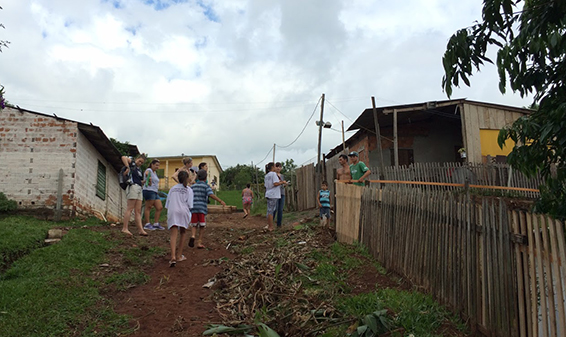BTN.com staff, BTN.com staff, June 22, 2015

Students at Big Ten universities aren?t waiting until they get out into the ?real world? to make a difference. Find out how they?re working together to create positive, meaningful change in this BTN LiveBIG series: the Student Section.
 São Leopoldo is a long way from Ann Arbor, Mich. - right around 5,000 miles, to be exact.
São Leopoldo is a long way from Ann Arbor, Mich. - right around 5,000 miles, to be exact.
The small city near the southern tip of Brazil doesn?t really have much of an international profile. So why did 10 University of Michigan graduate students feel compelled to make the long trip there for two weeks in March?
It all started when Ana Paula Pimentel Walker, professor of urban and regional planning at Michigan, connected with one of her colleagues at The Pontifical Catholic University of Rio Grande do Sul, one of the top research universities in Brazil.
Through that correspondence, Pimentel Walker, a native Brazilian, learned about a community-wide effort to figuratively and literally clean up Santa Marta, a ?favela? (the Portuguese word for ?slum?) within São Leopoldo.
?Most people are ashamed to live in the neighborhood,? said Ana Carolina, a 15-year-old high school student from that community. ?I?ve suffered a lot of discrimination for being a Santa Marta resident. I want people to have pride and feel good about living in our neighborhood.?
Carolina, her fellow classmates, and her teacher, Sandra Grohe, joined forces to create The Santa Marta Municipal School?s Com-Vida program, an environmental education initiative designed to reverse the rising tide of violence, vandalism and pollution in the favela.
?I understood that a change was necessary for any kind of progress in the community, which has been suffering with constant fighting and the destruction of the heritage,? Grohe said. ?The students had to start learning how to take care of the classroom, their own space, to then be able to expand the notion of citizenship for the neighborhood.?
News of the effort spread further and more quickly than anyone could have imagined. Soon after, Pimentel Walker found out about the program and was intrigued by the opportunities for education and impact.
?I was committed to offering an international [urban] planning capstone course,? Pimentel Walker said. ?The goal [was] to allow students to work with a client-partner in finding solutions and to develop alternative plans for a real-world urban planning problem.?
Santa Marta proved to be the perfect opportunity to implement the course. So, along with her class of 10 graduate students, Pimentel Walker traveled to São Leopoldo to collaborate with and advise the community?s program.
Even though the language barrier was difficult to overcome at first, both groups were able to adapt in spite of it.
?The language barrier became a blessing because we ended up partnering with middle school students from Com-Vida to collect all the data,? Pimentel Walker said. ?I trained them in data collection and they worked side-by-side with UM students, forming deeper connections that brought the project to a higher level of understanding of the local reality, which ultimately improved the quality of the recommendations.?
One of their first orders of business was tackling the issue of waste removal, since residents usually resort to burning trash or throwing litter into the water.
?Santa Marta grew around a former open dumpsite,? Pimentel Walker explained. ?Although the dump has been closed, the community [identified] waste management as the main problem affecting residents and the creek that crosses the area.?
The graduate students proposed that both the community and the local government come together in order to effect change.
?They have to improve infrastructure,? said Julia Mantey, a UM graduate student. ?If the garbage trucks can reach all streets and collect trash, the residents will have more quality of life. This is my hope for them.?
By preparing a map of Santa Marta with the data that the students collected about dumpsites, flood areas, and poorly lit sections, the community will hopefully become a safer place for its residents.
?I?m very happy and excited because I believe we will be able to implement a majority of the students? suggestions in my community,? Carolina said. ?I can?t wait to share the results and start putting them into practice.?
The most memorable experience of the project for Carolina occurred when she and her teacher were able to fly back to Michigan?s campus in order to attend the final presentation of the project and give feedback.
[btn-post-package]?Usually, international studios and service-learning courses lack the resources to bring those they serve to the United States,? Pimentel Walker said. ?The fact that not only were UM students able to learn about life abroad, but also a Brazilian teacher and her student were able to visit our students, made this project on urban planning ? a little more reciprocal.?
And there wasn?t a dry eye in the room when Carolina tearfully expressed her gratitude in front of the class.
?You went there just to help us out,? she said. ?You chose our project. It meant a lot to us.?
By Ashley Lemaine







